Text
Arcane Redemption Post-mortem
In the end, we had a total of 9 participants who playtested our game. Ranging from participants who were completely inexperienced with video games, to participants who play games regularly, we were able to collect feedback from a variety of perspectives.
Demographic wise, none of the playtesters outright disliked games of the bullet-heaven wave-survival genre, however, most of them had not played games of the genre previously. The same goes for related genres of bullet hells and roguelikes. Most playtesters did not outright dislike the genres, however it was not their favourite, excepting Playtester 9, who stated roguelikes as one of their favourite genres, and along with Playtester 3, strongly agreed that they enjoyed all genres questioned, including the genre of Arcane Redemption (Bullet-heaven Wave-Survival).
All playtesters (apart from playtester 2, who found the game lacked challenges) reported the game to be fun and easy to learn, with a suitable level of challenge.
Most participants liked the aesthetics of the game, and felt the design for the sprites appealing and combined well together. The feedback for the game audio was generally positive, with many playtesters commenting that the music was good and suitable for the game. However, of course, the game ran into a lot of issues. Based on the survey given out to the participants towards the end of the game, we compiled a list of issues found, how severe they were and possible fixes to them:




Most of the issues were due to unfinished and unadded aspects. Conducting a thorough playtesting session was crucial for refining our game and ensuring a better final product. By gathering feedback, observing player interactions, and coming up with ways to improve current issues in the game, we believe this game can go further than just a prototype:]
1 note
·
View note
Text
Dev blog (3): Playtesting!!

Last update for the One Page for Arcane Redemption. While the prototype we put out did not reach the status we fully expected it to be, the product was playable, there were not many game-breaking bugs, and playtesters overall had a positive reaction to the game. We had the game playtested by a total of 6 people during the playtesting party (we may invite more playtesters during the week) and got some valuable feedbacks.
In chapter 12, p266 of prof. Fullerton's book on Game Design, she emphasized that providing visual or aural feedback to confirm a player's action is essential. A good designer ensures feedback for every player action, so always incorporate feedback systems early in your digital prototype to test their effectiveness. Before the playtest, we briefly introduce the participant to the game, and stated that they were allowed to freely speak what they think out loud in order for us to understand what went through their mind when they encounter certain events of the game, as well as handing them a questionaire.
During the playtest, while we allowed the participant to explore the game without any intervention, we took notes of whatever the player thought, as well as bugs or interesting findings. At the end of the session, the participant was given a survey, and we explained certain limitations of the game (stuff we could not put out in time, resulting in the product having certain bugs or incomplete segments)
Overall, this was a very fun and valuable experience for us, as this is the first time we've ever put out a product and have a formal playtesting session for it. We'll use the feedbacks we got to further complete the game :]
1 note
·
View note
Text
Dev blog (2): More sprites and final touches
Bullet sprites for Fire and Poison, which will be the first 2 types of spells implemented for Arcane Redemption.
Fire spell: Deals a small explosion on hit, which creates an expanding AOE damage zone
Poison spell: Deals ticking damage overtime on hit




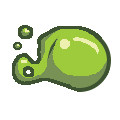
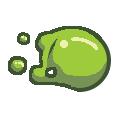
Our group plans on adding an additional 3rd spell, which is Lightning, but with our time limitation, the lightning spell will be left as a concept.

We have made our own list of which elements need to be prioritized (as suggested by prof. Fullerton's book on Game design in chapter 5, page 85) as we have limited time to put out a prototype. And it's better to have a working product before expanding more on it.
For the playtesting party, I'll be taking on the role of the notetaker and carry out the surveys towards the end
1 note
·
View note
Text
Dev blog: Working as a team, and working on sprites for Arcane redemption
As one of the sprite artists for the game, I'm responsible for creating sprites, as well as animation and sfx for them.
Our team saw the same vision for the game, but we still ran into some communications as to how to approach a specific aspects of the game. As said in chapter 12 of prof. Fullerton's book on Game Design, views may clash, and it takes compromisations when you're working with a team. As the visual artist of the project, I was given full freedom in creativity, but ultimately when it came to the final product, the game designer and I had to sit down and discuss what we really want to implement, given the time limitation and the programmer's ability to bring the sprites to life. A way to solve this was to have regular meetings (suggested in p411), and it was easy since we're all attending the same workshop.
As I've had limited experience in animation, this was a great opportunity for me to delve more into it. Visual cues play an important part in signaling what's happening in the game, so the enemy sprites all have to have separate animations for the different states: idle, attacking and death
For example, we decided to create this simple bat enemy that will move move towards the player and ignore terrains as it goes.



Here's another enemy I worked on: A Spirit that will pursue the player til it reaches a certain range, stop, and fire projectiles at the player

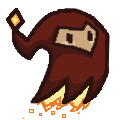

death animation for the Spirit:




This has helped me get used to creating sfx and communicate visual signals better.
0 notes
Text
Arcane Redemption - new group project!
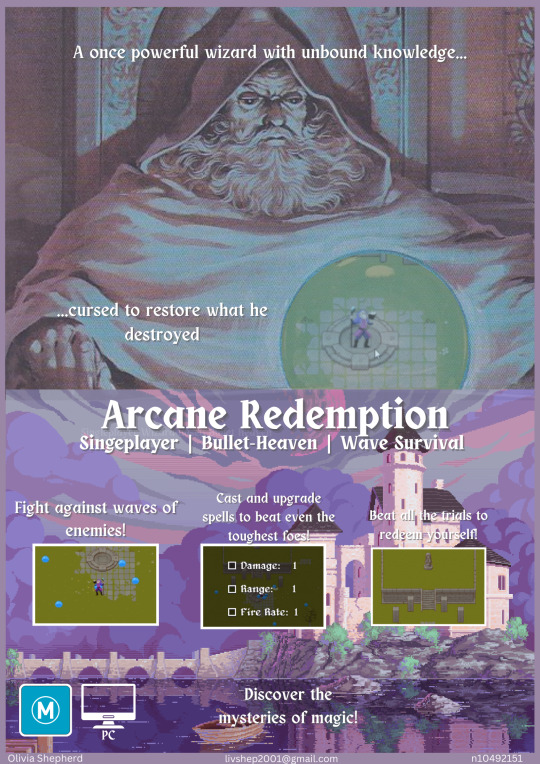
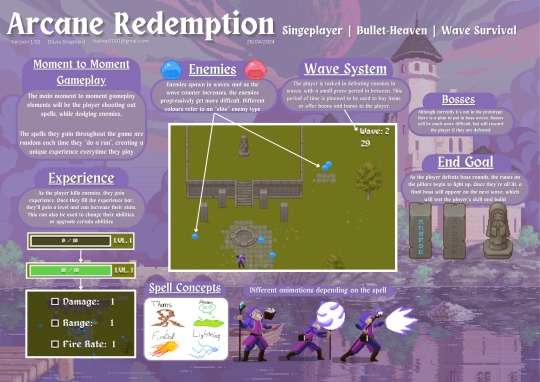
(Illustrated by Olivia, the lead programmer for our group)
In this last assignment, we get to form groups and decide on a game to work on together. This is a valuable opportunity to improve my communication and co-operation skills in a group setting. Our group has 4 people, and we distributed our group very evenly from the very beginning: We have 1 lead programmer, 1 lead game designer, and 2 artists who will work on creating assets for the game. I took the role of a concept artist for the game.
According to prof. Fullerton (2018), concept art is particularly vital to capturing and defining the overall feel of a game. This visual tool not only helps to establish a cohesive artistic direction but also serves as a key element in conveying the intended atmosphere and emotional tone of the game. With Arcane Redemption, we wanted to explore a more classic/retro-esque feel with the pixel artstyle, with the setting in a fantasy wizard world. Another important part of our assignment is to carry out playtesting formally. This will include handing out surveys, questionaires, writing reports and notetaking. We have to set realistic goals for our game prototype, so it can be a playable product by the time the playtesting party comes:
Implement a working top-down shooter mechanic with at least 2 different variations of attacks
All of the enemies with different challenges should be designed to be distinct enough from each other, and implemented in the game
Additional dialogues to create an overarching narrative that drives the player forward
0 notes
Text
Finalized Sell-sheet and One-page for personal platformer project
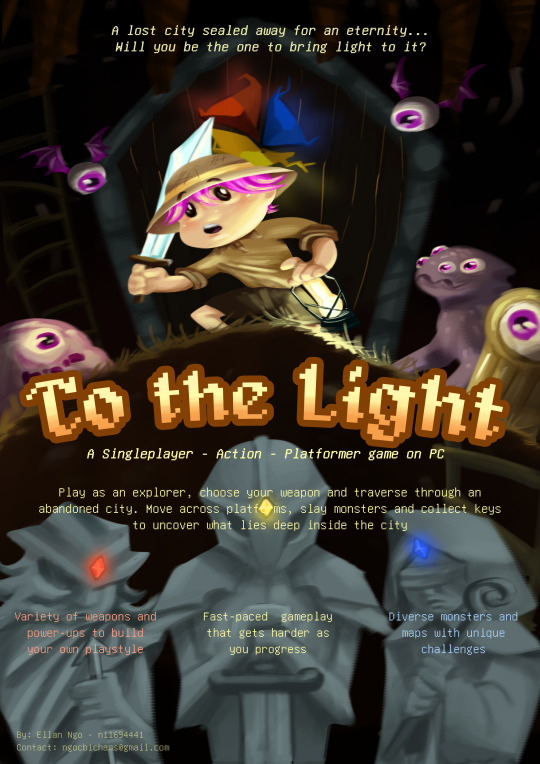
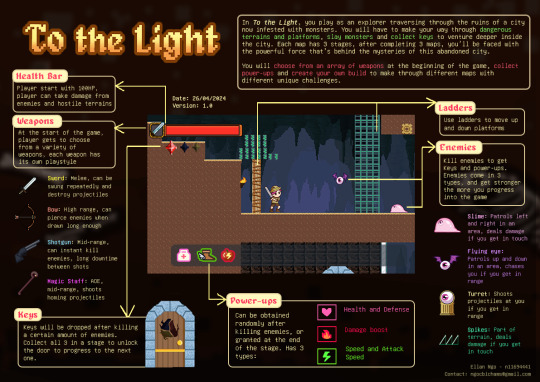
(Illustrated by me:])
The platformer project ive been working on from the very beginning of the semester now has a detailed sell-sheet and one-page. While making these, I had the opportunity to reflect on my own game design and expand on the original ideas i envisioned for the game.
It's a simple extension on the classic platformer game, but with enough new implementations to keep the moment-to-moment gameplay engaging. I tried to combine different types of resources management together to create an original game experience (as suggested by prof. Fullerton in chapter 3, p92 from her book: Game Design Workshop) and hope it can turn out to be a well-crafted prototype.
1 note
·
View note
Text
Playtesting and Post-mortem for Asteroid game
I decided to create my own assets for this game to match the aesthetics I wanted for it. The ideas and gameplay is still similar to what we were provided in the workshop, but now it's a complete game with working mechanics
I had the game tested out by a group of friends and also decided to change some miscellaneous stuff:
○ The first one being the size of the ship. In my first version, playtesters reported that the ship was hard to navigate and had a hard time avoiding the rocks, so I decided to adjust the size, as well as the movement speed + rotation speed for the ship.
○ The 2nd thing I changed was the size difference between the rocks. I wanted the obstacles to have a bit more diversity in challenge, so I changed the speed of the rocks as well (the smaller the rock is, the faster it is)
○ The final one being the size and visuals of the bullet. Playtesters reported that the bullet was hard to see, I decided to make it neon bright so it stands out better on the background
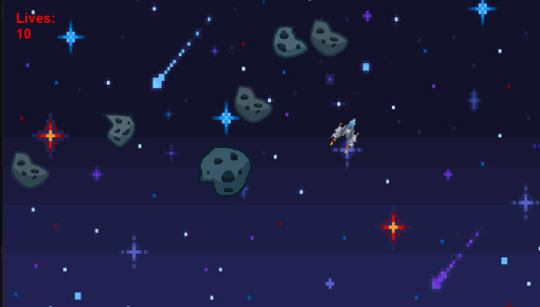
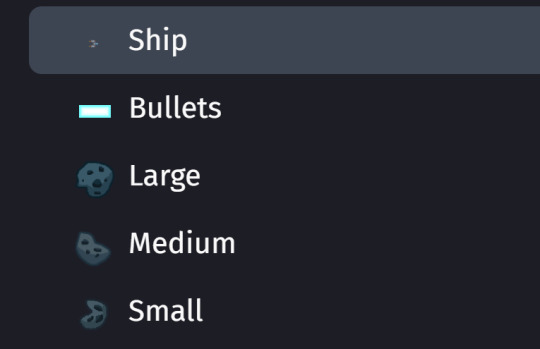
0 notes
Text
Space Glider final additions and Post-mortem

In chapter 5 of prof. Fullerton's writings on Game Design, she emphasized the need to have a connection between objects and resources in the game to keep the game engaging(p131). In my latest version of the game, I added some last UI elements, es well as implemented the power-ups: An instant temporary speed boost, Fuel for the fuel bar, Extra lives and an instant temporary invincibility boost.
Playtesters wanted to see an expansion on the classic racing game, and my aim was to create a racing experience that felt exhilarating and responsive. So besides the health resource, players will have to manage the Fuel bar. Whenever the fuel bar is full, players are awarded with a temporary period of speed boost and invincibility.
Some challenges during development:
I had to ensure that the game was fair yet challenging. Playtesters reported that some obstacles in the lanes are too big and too fast to avoid.
The power-up's visuals were too bland and didn't feel noticeable, and some playtesters suggested adding some visual effects (like a glowing or some simple animation) or sound effects.
With the feedbacks above, I believe I can have Space Gliders a finished product soon:] I'm going to take these insights into my next project, ensuring it’s an even more exhilarating and polished experience for players.
0 notes
Text
Racing game development - Space Glider
In Space Glider, you're running away from a giant space monster trying to catch up to your vehicle. Your objective? try to survive for as long as possible. Along your ride, you'll have to avoid obstacles (space trash) and try to collect some Gears to earn temporary power buffs (some extra speed, invisible to obstacles, or maybe even an extra life). You'll have 3 lives, so try not to get hit too much.
During the workshop working on this game, we got introduced to Object groups, which helped me solve a lot of problems on my previous games (really useful for some of my coding problems) and helped me assign the functions (gears or obstacles) to a lot of objects in this game.
I am yet to implement the monster, but I found the aesthetic I wanted to go for:)

0 notes
Text
Asteroid development
Besides the platformer that I'm working on, we're also introduced to the next project, which is an asteroid game.
It's very different from the aesthetics of my platformer, but the work I've done for my previous game really helped me get a fast start on this one. This definitely brought me back to the old flash games I grew up with:) Still working on the vision I want for this game, but for now it's a space craft shooting at rocks set in a whimsy little galaxy far far away .

0 notes
Text
postmortem and playtesting (part 2)
Playtesting is important. very important. i was very nervous with showcasing an unfinished product to other people, but my takeaway from reading prof. Fullerton's Game Design Workshop, is that it's important to get your game tested out by other people throughout its production, even during the earlier stages (the point was emphasized at the very first chapter and repeated throughout until at least chapter 6). So after having 2 other friends test out the game, i've made some changes to some aesthetic choices and fixed some bugs.
the first change was with the 'trees' that are supposed to be climbable. the first design didn't correctly convey that players can use them to get to higher levels, so i tried adding some vines and make the tree trunk bigger (i'll definitely go back to this)

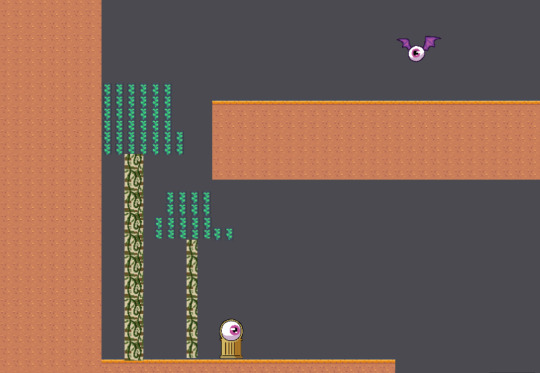
the second thing i fixed is in the "coding". the previous problem regarding the animation of my sprite attacking (swinging a sword) was fixed. turned out i had the animation on "loop", which messed with the key pressed to activate that animation. i intended to make the character sprite knocked back a certain distance, but it didn't work and my character gets sent back infinitely. i finally fixed it by adding a "timer" that gives a lilttle more "effect" to the character being hit. it allows the player to get slowed down and stop the force that send the sprote back infinitely. it works well now and i can move on with the combat system

(image of fixed code)
4 notes
·
View notes
Text
Progress and testing
I've set up the layout for my platforming stage, the next thing I'm figuring out now is how to set up enemies in random locations, as I want them to spawn randomly and new types of enemies to spawn as you progress longer into the stage. I've also tried a few runs around and tested if the gap between terrains or just where they're set up are logical, and tried to make the platforming aspect a bit more challenging by adding hostile terrains (spikes). For now I find them reasonable, but I'll definitely find other playtesters and get some feedback from them.
As I've mentioned before, I want them game to get a bit more challenging the further you progress into the stage, so I plan to have 3 types of enemies around the map, with both melee and range attacks. The premise is that after you've killed a certain amount of monsters, a key will spawn and the next type of monster will spawn. Your objective is to collect all 3 keys to advance to the next stage.
As quoted from chapter 4 of prof. Fullerton's book on Game Design: "a game has clearly defined goals, the players know what needs to be done to win, to move to the next level, to achieve the next step in their strategy, etc . , and they receive direct feedback for their actions toward those goals". I want to implement rewards, as well as more sound and visual cues for when the player character achieve the above mentioned objectives.
I'm currently trying to make the healthbar work, as well as fix up some controls. I'm struggling with making my character swing their sword. Even though i've set up all of the animation frames just fine (the preview runs the animation smoothly), the key that triggers the animation only trigger the first frame of animation. Hope to get it fixed so I can carry on with my combat system.


1 note
·
View note
Text
Sprites (and an attempt at animation)
For my personal prototype project, I plan to borrow platforming assets (platforms, backgrounds, other objects, etc) from asset stores. And while I have very limited experience in animation, i decided to create my own sprites for the game.
The main animations that are going to be used in the game will be: Idle, Walking, Attacking (swinging sword) and Jumping (and an additional death animation, but I'll rely more on the already available effects in Gdevelop). I used references from the already existing sprites to create them

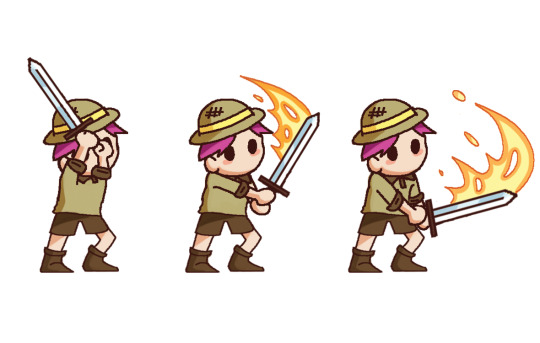
3 notes
·
View notes
Text
Idea for weapons/ mechanics
For this game, I want the player to be able to choose their own weapon that suits their playstyle, and currently I have ideas for the first 3 weapons I want to introduce to the game
Firstly, I want to design the sword as a melee weapon, but can be swung repeatedly with very little down time in between and can destroy projectiles.
The second weapon is a bow, a long range weapon with a slightly longer downtime in between arrow shots compared to the sword, but if you hold the weapon for a certain amount of time, the arrows can pierce through a row of enemies and instant-kill them.
And finally, a mid-range shot-gun that can shoot powerful projectiles and can instant-kill enemies (one at a time), however, the downtime between shots is the longest of the 3 weapons.
In the prototype version, i'll be focusing on the melee weapon: the sword
0 notes
Text
Elevator pitch for a platforming game:
You play as an adventurer, guided by the prophecies of ‘Past heroes’ , on a quest to uncover the mystery behind the ruins of an ancient city. Along the way, you’ll find the monsters infesting the city and you have to make your way through by slaying them.
At the start of the stage, you get to choose your weapon which comes in the form of a "Blessing” from one of the ‘Past heroes’. Each weapon has a different style of playing, either close range or long range, and has different perks.
As you slay the monsters, they’ll drop keys, and after you collect enough keys, you’ll be able to unlock the gate to the boss of the stage. The monsters will also drop random powerups, which can include health, extra speed, extra attack speed, etc (think of items from Risk of Rain 2) and some might cooperate well with the weapon you initially chose. After you’ve cleared 3 stages, you’ll face the final boss of the game (who or what is it? It’s a surprise:3)
The game mechanic is influenced by a lot of roguelikes and platformers. I want the game to have a subtle story, with bits and clues scattered around that can be pieced together and interpreted by the players themselves. This is the initial draft, the story will (and definitely) be expanded upon in the future.
#elevator pitch #development
2 notes
·
View notes
Text
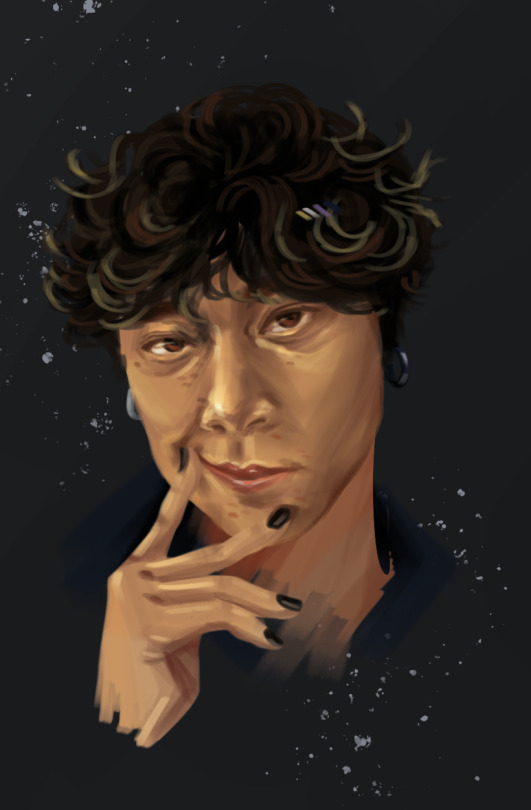
Hi, I'm Ellan Ngo. I'm currently a first year undergraduate doing Bachelor of Games and Interactive Environment at QUT. As you can probably tell, I'm into video games (currently fixating on roguelikes and horror games) and art (i love doing both traditional and digital art!)
I'm particularly fond of the art of video games. I love coming up with different world settings, making character and environment art concepts. I always have ideas for a level design, or how a boss fight should take place! In the future, I hope to not only become a concept artist for video games, but also be able to create my own games. By the end of my studies, I aim to become more fluent in programming, acquire valuable industry-relevant skills, as well as participate in multiple projects and collaborations with others in the industry.
For now, I'm still learning and experimenting, one day I hope to see some of my ideas come to fruition:)
4 notes
·
View notes